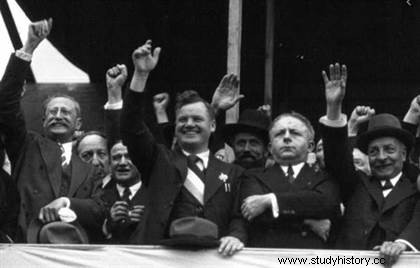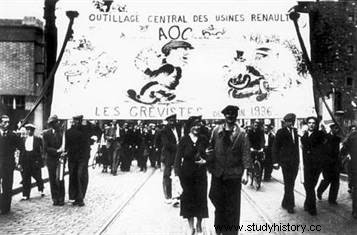 The Popular Front was a coalition of different left-wing parties that governed France from June 1936 to April 1938. A major event in the memory of the French left, the arrival of the Popular Front in government under the leadership of Léon Blum was motivated in part by the violence of February 6, 1934. The left, hitherto disunited between radicals, socialists and communists, joined forces to stand up against the rise of the extreme right. An unprecedented wave of strikes reinforces the government in its negotiations with the bosses. The balance sheet is important, with paid holidays, collective agreements, salary increases...
The Popular Front was a coalition of different left-wing parties that governed France from June 1936 to April 1938. A major event in the memory of the French left, the arrival of the Popular Front in government under the leadership of Léon Blum was motivated in part by the violence of February 6, 1934. The left, hitherto disunited between radicals, socialists and communists, joined forces to stand up against the rise of the extreme right. An unprecedented wave of strikes reinforces the government in its negotiations with the bosses. The balance sheet is important, with paid holidays, collective agreements, salary increases...
The awakening of the left
Since the crisis of 1929, the economic and political malaise has benefited the left, which won the elections of May 1932. Its militants readily interpret the riots of February 6, 1934 as an attempt to fascist coup d'etat and demand from their respective parties unity of action against the right-wing leagues. These riots highlighted the weakness of the political system in the face of attempts at destabilization and the danger that the leagues represent for democracy. In April 1934, the General Secretary of the Communist Party, Maurice Thorez, went to Moscow and, upon his return, sought active cooperation with the Socialists. In July 1934, Communists and Socialists signed a pact of unity of action.
 In August 1935, the VII Congress of the Comintern (the Communist International) confirmed this orientation; the communist movement renounces the "class against class" tactic (which, since 1928, consisted in refusing any alliance with the socialists, qualified as "social-traitors") and recommends the formation in all countries of "united anti-fascist fronts" or "popular fronts".
In August 1935, the VII Congress of the Comintern (the Communist International) confirmed this orientation; the communist movement renounces the "class against class" tactic (which, since 1928, consisted in refusing any alliance with the socialists, qualified as "social-traitors") and recommends the formation in all countries of "united anti-fascist fronts" or "popular fronts".
The rapprochement of left-wing parties is also favored by the resignation of Doumergue, disappointed at not having been able to complete his plan to strengthen executive power. Laval, who succeeded him after a short-lived Flandin cabinet, played into the hands of the left with his financial and foreign policy. Attached to the gold parity of the franc, it refuses to devalue to boost exports and prefers to reduce production costs in the hope of regaining foreign markets. Pierre Laval engages by decree-laws a rigorous deflation:reduction of 10% of all the public expenditure, including the retirements, the salaries of the civil servants and the pensions of the veterans; increase in the tax on securities and the tax on high incomes.
The left denounces "decrees-laws of misery" and capitalizes on the discontent of public opinion. The Radicals decided, at their October 1935 congress, to leave the National Union and join the Popular Front. On the other hand, in 1935 Laval signed an agreement with the U.S.S.R. which provided Stalin with the opportunity to publicly endorse the French policy of rearmament against Germany. As a result, the French Communists, who had refused to vote on the military budget since 1920, began to vote again on national defense credits and thus emerged from their political isolation. Nothing therefore stands in the way of their rapprochement with the radicals.
The victory of the Popular Front
As the April 1936 elections approached, radicals, socialists and communists multiplied united demonstrations around common slogans ("bread, peace, freedom", " fascism will not pass”). Each party undertakes to withdraw in the second round in favor of the best-placed Front candidates. On May 3, 1936, this voting discipline gave the left 160 seats ahead of the right. Léon Blum acceded to the presidency of the council and on June 4, 1936 formed the first French government with socialist leadership:it included three women and many radical ministers. The Communists support it without participating in it.
 At the same time, a wave of strikes with factory occupations spread across the country and affected nearly two million employees. Employers and the C.G.T. reunified sign on June 7, 1936, in the presence of the government, the Matignon agreements which establish collective labor agreements and increase wages by 7 to 15%. A few days later, social laws limit the working week to 40 hours and establish twelve days of paid leave per year. These decisions lead Maurice Thorez to ask employees to return to work (“You have to know how to end a strike”).
At the same time, a wave of strikes with factory occupations spread across the country and affected nearly two million employees. Employers and the C.G.T. reunified sign on June 7, 1936, in the presence of the government, the Matignon agreements which establish collective labor agreements and increase wages by 7 to 15%. A few days later, social laws limit the working week to 40 hours and establish twelve days of paid leave per year. These decisions lead Maurice Thorez to ask employees to return to work (“You have to know how to end a strike”).
The government takes control of the board of directors of the Banque de France, and to stabilize the income of farmers, a Wheat Board is created, which sets a guaranteed minimum price cereals. In 1937, the railway networks were nationalized and grouped within the S.N.C.F. The war industries come under state control, and the Blum government immediately begins the rearmament of France.
The dilemma of the Spanish Civil War
Since the electoral victory of the Frente popular in February 1936, French opinion followed the Spanish situation. When in July the garrison of Spanish Morocco rose up at Franco's call, the Madrid government sent an urgent telegram to Léon Blum:"We are surprised by a dangerous military coup. Ask you to help us immediately by arms and planes. Fraternally yours. Giral. »
The same day, l'Humanité, le Populaire (socialist newspaper) and l'Ère nouvelle (radical of Herriot tendency) proclaimed the solidarity of the Popular Front with the Frente popular. On the 20th, Léon Blum urged his Minister of Foreign Affairs, Yvon Delbos, and his Minister of War, Édouard Daladier, to defer to the appeal of the Spanish government. On the 23rd, Blum was in London in the hope of involving the British in his intervention project:he was refused. The same day, a controversy broke out in the press. L'Écho de Paris publishes an article by Raymond Cartier entitled:“Will the French Popular Front dare to arm the Spanish Popular Front? The following days, the same newspaper underlines the disapproval of the English and provides details on the shipments of French planes.
The Popular Front splits:Communists and Socialists approve of the intervention; the radicals blame it by the voice of Herriot. Daladier and Delbos, both radicals, find themselves at odds. The general staff and the President of the Republic Albert Lebrun are worried. At the extraordinary council of ministers of July 25, 1936, the ministers were divided and the climate tense. A transaction intervenes:we will transport the material as discreetly as possible, under cover of Mexico, but officially, we will deny it with energy.
The rise of difficulties and the end of the Popular Front
 As early as 1937, the Blum government was beset with difficulties. The attitude to be observed vis-à-vis the Spanish Civil War divided the government. The right hardens its opposition. The nationalist press (Action française, Gringoire, Candide) exudes hateful anti-Semitism against Blum and harasses some of his ministers such as Jean Zay and especially Roger Salengro, whom it drives to suicide by accusing him daily of desertion during the war.
As early as 1937, the Blum government was beset with difficulties. The attitude to be observed vis-à-vis the Spanish Civil War divided the government. The right hardens its opposition. The nationalist press (Action française, Gringoire, Candide) exudes hateful anti-Semitism against Blum and harasses some of his ministers such as Jean Zay and especially Roger Salengro, whom it drives to suicide by accusing him daily of desertion during the war.
But it was above all the inability to resolve the economic crisis that explained the disintegration of the Popular Front in the spring of 1938. Unemployment persisted, industrial production stagnated, the budget deficit is deepening and the gold is leaking abroad. The devaluation of the franc (October 1, 1936) gave exporters a chance, but the rigid application of the 40-hour schedule demanded by the unions created bottlenecks in the sectors where orders resumed.
In the absence of being able to modulate working hours, equipment would have to be modernized to increase productivity. However, employers refuse to invest for fear of new occupations of factories. Investments fell by 11% in two years and capital was all the more easily placed abroad as Blum renounced all exchange controls. Discouraged, Blum resigned in June 1937, and the Popular Front broke up in March 1938. It was an economic failure, because wage increases were absorbed by rising prices, but this failure leaves the memory of a success, because the social laws of June 1936 restored the dignity of the working class.
Bibliography
- History of the Popular Front. The Beautiful Escape, by Jean Vigreux. Talandier, 2016.
- 1936, the world of the popular front, by Serge Wolikow. Looking for Midi, 2016.
- The Popular Front, by Jean Vigreux. PUF, 2011.
